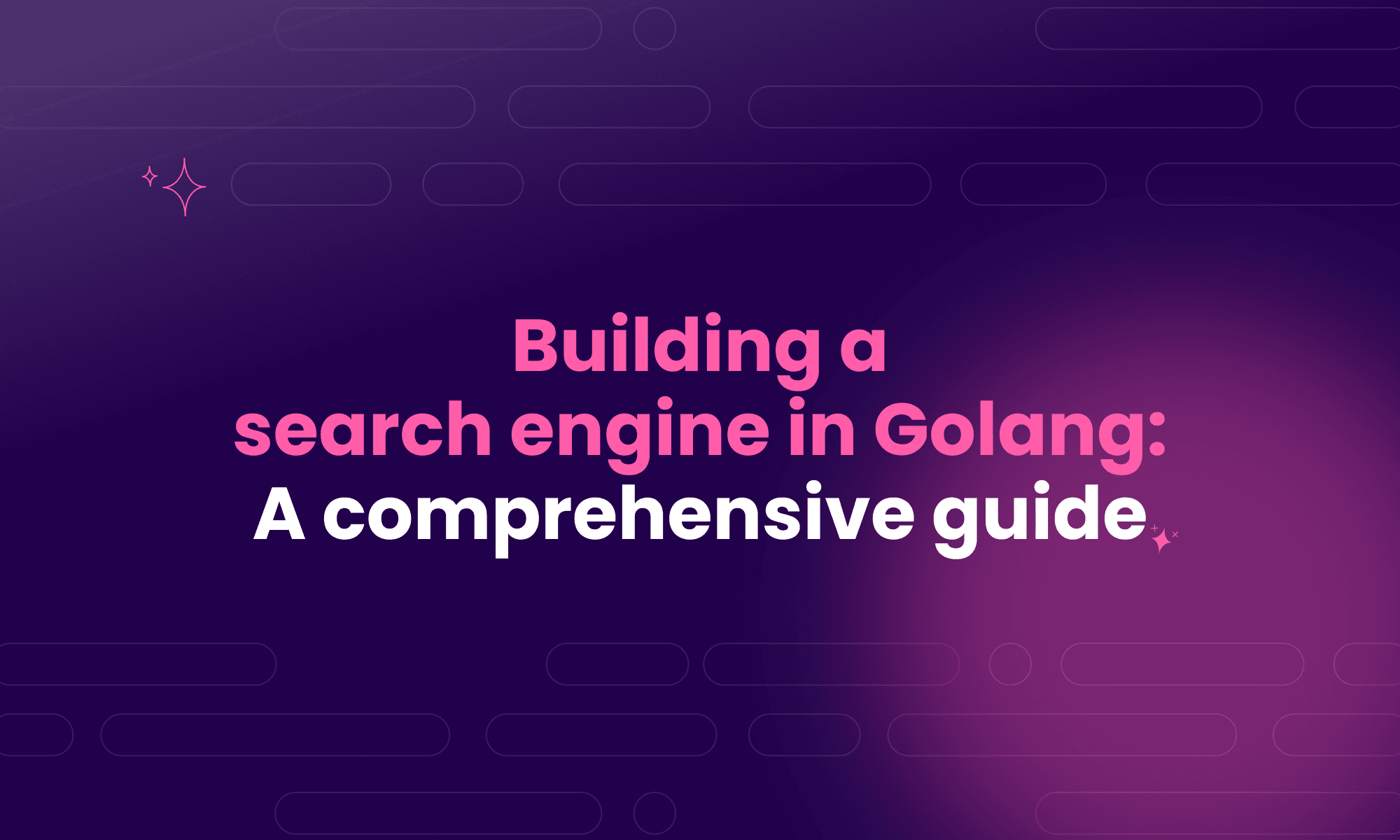Building a search engine in Golang: A comprehensive guide
Learn how to easily build a search engine in Go (Golang) in this actionable step-by-step tutorial.

If you want to build a fast and reliable search engine, the simplest answer is Golang and Meilisearch Go SDK. Combine these, and not only can you index your content as it should be, but you can also search queries within milliseconds and keep everything lightweight as ever.
In this guide, you’ll learn how to:
- Set up Go and connect it to Meilisearch
- Index structured data using JSON
- Build a clean API for real-time search
We’re going to share a method that is simple, fast, and works at scale flawlessly. This guide will help you avoid all the heavy frameworks and large teams that only slow you down. So, if you’re ready to build a lightweight search in Golang, let’s begin.
1. Set up your Golang development environment
First, you must prepare your Go environment and install the Meilisearch Go SDK. This is the primary prerequisite for building your search engine. It’s crucial because it enables your system to actually run Go code and communicate with your Meilisearch instance.
Start by initializing your Go module:
go mod init search-engine
Then, install the Meilisearch SDK:
go get github.com/meilisearch/meilisearch-go
Again, we must confirm that Go is installed and Meilisearch runs locally or in the cloud. Then can use this setup to index data and handle queries for API creation.
Once your environment is ready, you can connect to Meilisearch and start building.
2. Connect to a search engine database
Before all the indexing and searching, your Golang project must connect to a Meilisearch instance.
Meilisearch is an open-source, lightning-fast search engine that supports real-time search. It is also capable of typo tolerance and full-text indexing, making your search even more potent. It’s time to connect the Meilisearch Go SDK to your database and perform search operations.
Here’s how to initialize the client in Go:
package main import ( "github.com/meilisearch/meilisearch-go" ) func main() { client := meilisearch.NewClient(meilisearch.ClientConfig{ Host: "http://127.0.0.1:7700", APIKey: "masterKey", }) // Use `client` to index documents and run search queries }
Remember, if you’re using the hosted version, you must replace the host URL with the respective Meilisearch Cloud address.
Once connected, your Go application can add documents, create indexes, and run lightning-fast search queries with Meilisearch’s JSON-based API.
3. Create your document indexing logic
Is your Go app connected to Meilisearch already? Next up is indexing your data. Since Meilisearch works using JSON docs, you must define your content in structs before pushing it to the search engine. This enables full-text search, filters, and fast retrieval.
Here’s how to index documents in Go:
type Movie struct { ID int `json:"id"` Title string `json:"title"` Genre string `json:"genre"` } movies := []Movie{ {ID: 1, Title: "Inception", Genre: "Sci-Fi"}, {ID: 2, Title: "The Matrix", Genre: "Action"}, } res, err := client.Index("movies").AddDocuments(movies) if err != nil { log.Fatal(err) }
Each document becomes searchable immediately after it is indexed. You can create multiple indexes like “products,” “posts,” or “users,” depending on your project. Document indexing is the backbone of your Golang search engine. This is the reason why Meilisearch can parse and retrieve results in milliseconds.
4. Build the search API and frontend
The connection is set, and the documents have been indexed. It is time to build the search functionality into your Golang application. The aim is to create an API endpoint that takes the search query to Meilisearch and returns the desired results. This is where features such as full-text search, typo tolerance, and filtering truly matter.
Here’s a simple search handler in Go:
http.HandleFunc("/search", func(w http.ResponseWriter, r *http.Request) { query := r.URL.Query().Get("q") searchRes, err := client.Index("movies").Search(query, &meilisearch.SearchRequest{}) if err != nil { http.Error(w, err.Error(), http.StatusInternalServerError) return } json.NewEncoder(w).Encode(searchRes.Hits) })
Another good news is that this endpoint can be integrated with various frontend frameworks, such as React, Vue, plain HTML, and JavaScript. The accuracy and speed of all search results depend on the Meilisearch Go SDK.
5. Test and refine your Golang search engine
With your Golang search engine running, it's time to test real queries and improve your results, using all the capabilities we have covered so far.
The next step is to search queries using partial matches, typos, and filters. Track how Meilisearch ranks and returns results. Measure speed. Review how your backend handles load. If using the Meilisearch Go SDK, confirm that your API responds in milliseconds and parses JSON documents accurately.
Want deeper insights? If you're using Meilisearch Cloud, check the built-in analytics:
- Track top search terms
- Monitor failed searches
- Analyze performance by endpoint
Refine your transformer logic, tweak rankingRules, adjust typo tolerance, or set filters like filterableAttributes.
What are some examples of Golang search engine uses?
If your goal is to build a fast search engine that’s equally responsive and lightweight, Golang is ideal. It provides a bonus set of features, including typo tolerance, ranking rules, and filterable results, when combined with the Meilisearch Go SDK.
Let’s look at some of the most frequent and efficient use cases for search engines in Go.
- App search: This is one of the most prominent uses of a Go search engine. Startups using lightweight applications with custom algorithms and text analysis often opt for this. Plus, they get a responsive UI and can use tokenization to handle dynamic query input in literal milliseconds.
- Site search for blogs and documentation: You can use Golang with Meilisearch to build fast, Boolean-enabled search features that support conjunction and disjunction queries. It can crawl and index Markdown or JSON content from static site generators like Gatsby or Hugo.
- eCommerce product search: When customers visit your e-commerce store, they don’t have the time for time-consuming or inaccurate search results. You will lose that customer instantly.
To avoid such situations, developers use Golang with Meilisearch to create smart search functionality that retains customers through filters such as price, tags, category, and in-stock items. - Internal tool search: It is also used in internal systems for teams. For instance, a team handling tools without a dedicated search system will frustrate members because they cannot find the tool they seek.
On the other hand, if you use Go and Meilisearch, you can build an instant search system with quick and accurate response times. It utilizes the principles of tokenization and exact matching to return search results from your dashboards, CRMs, and inventory tools. - Knowledge base and help desk search: When someone needs help, they don’t want to dig through articles. Meilisearch resolves this by giving them instant search results through Boolean logic and tokenization. Add Golang on top of this, and you can tie all of this together rather nicely.
- Regulated industry search (legal, healthcare, finance): Private records are private for a reason. They are only available to a certain number of people. And these people expect to find these private records instantly. For instance, large datasets like legal contracts or medical files must be indexed properly so the search engine can bring them up quickly.
Search engines built with Golang and Meilisearch are better than those without them, especially regarding performance, relevance, and customization.
Which languages besides Go are used to build a search engine?
We’ve learned how great Go is, and how it gets even better when paired with Meilisearch. Well, it’s not your only option. Various other programming languages can also help you develop real-time search features that might get the job done. Let’s look at some below:
- You can build a search engine in JavaScript if you're working with interactive frontend frameworks like React or Vue. JavaScript is perfect for browser-based apps that need fast, client-side search.
- Developers who want to work with data-heavy applications often build search engines using Python. It’s a flexible backend language that works well for indexing large datasets and performing complex queries.
- For server-rendered applications and CMS platforms, you can build a search engine with PHP. It’s ideal for adding search to WordPress, Laravel, or custom e-commerce backends.
Whichever you choose, Meilisearch offers SDKs and documentation to help you integrate search fast.
Can I build a search engine in Golang for free?
You can build a full-featured search engine in Golang for free using open-source tools like Meilisearch. Golang and Meilisearch are free to use and offer powerful capabilities out of the box—no licensing fees or paid tiers to get started.
You can run Meilisearch locally or host it on your own infrastructure without paying anything. Even if you scale later, it remains cost-effective with minimal setup and maintenance. The Meilisearch Go SDK handles everything from indexing to real-time queries with clean code and full documentation.
If you want a fast, flexible, and affordable search engine, Golang and Meilisearch are a great pair.
Building a Search Engine in Golang Made Simple
Building a search engine in Golang doesn’t need to be complicated. With the Meilisearch Go SDK, you can create a fast, lightweight, and scalable search solution using just a few lines of code.
Golang’s performance makes it ideal for backend services, while Meilisearch supports full-text search, typo tolerance, and efficient indexing with clean query string handling. You can define various query types depending on your content and use case.
Whether you're indexing JSON documents or managing custom data structures, the setup is simple and fast. This makes it great for app search, e-commerce, internal tools, or site search. If you’ve worked with BleveSearch or understand Rust syntax, you'll find the transition smooth and the developer experience clean.



